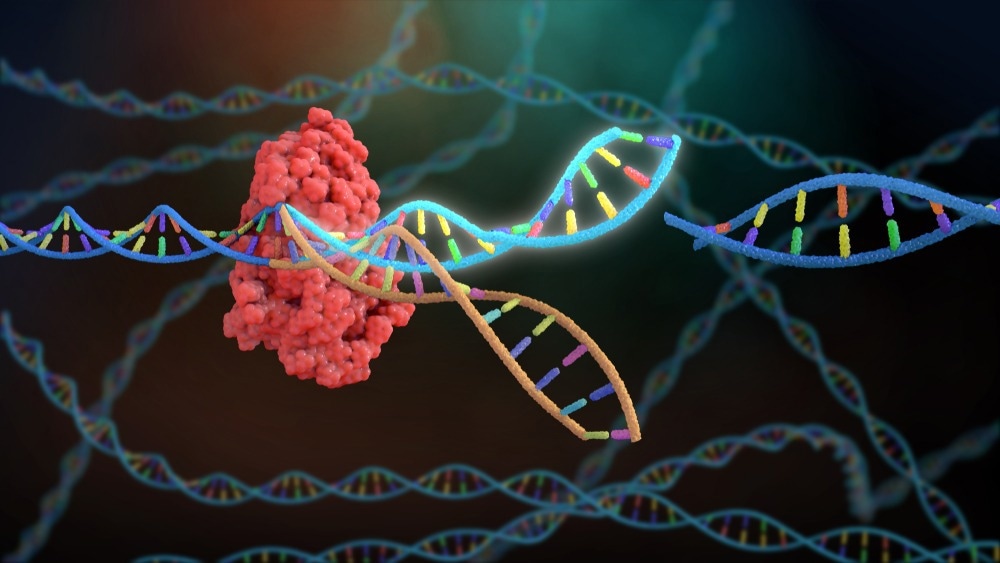At the core of modern drug discovery lies the identification of drug targets. Although on the surface level this may seem straightforward, the task is far from simple. Drug target identification is an important process in drug development as it can shape the efficacy and efficiency of the drug.

CRISPR. Image Credit: Nathan Devery/Shutterstock.com
Target identification is often the first stage in drug discovery. It requires an understanding of molecular pathways that are involved in the disease progression, then discovering a protein or gene that can be targeted to create a therapeutic effect. One of the more recent discoveries in this field of pharmaceutics is the use of CRISPR to investigate whole genomes and the functional consequences for that specific gene expression.
What is CRISPR?
CRISPR stands for Clustered Regularly Interspaced Short Palindromic Repeats. Essentially it is a genome editing tool that was first discovered in bacterial immune systems. It comprises a Cas Nuclease, which carries out the cutting part of the overall function, and a guide RNA that recognizes the sequence of the genome that requires editing. The bacterial immune system used it to cut out specific parts in the genomes of bacteriophages (viruses that target bacteria), therefore rendering them harmless. The uses of CRISPR have since been diversified to include genome engineering and the identification of drug targets.
How does CRISPR identify drug targets?
Researchers are now using CRISPR to evaluate the functions of many genes in the genome by “knocking out” specific genes and observing the difference this brings about. Knocking out a variety of different genes in different cells, that are then exposed to the drug of interest, can help scientists figure out which genes are causing the resistance to the drug and can then target those cells with different drugs to avoid the problem of resistance.
Another method researchers use to identify a drug target is by identifying the genes that promote the disease, targeting the proteins that are encoded by those genes, or targeting the pathway the relevant protein is involved in.
One significant change in the incorporation of CRISPR in identifying drug targets has been making a more reliable and quick model of disease so the drugs can be tested and observed. For safety and ethical reasons, scientists first need to test drugs on tissues and animal models, rather than on humans, and being able to knock out any gene required has allowed this to become a more reliable technique than ever before, allowing the model to mimic how the disease would react to the drug in humans. Therefore easing the process of finding drug targets.
Jonathan Wrigley the associate director at AstraZeneca has given an optimistic outlook on the future of CRISPR technology used for drug discovery, stating “It has proved transformative in the generation of cellular models to support drug-discovery projects.” AstraZeneca is now amongst the pharmaceutical companies using CRISPR in drug development.
Using CRISPR to exploit

Drug targets. Image Credit: VonaUA/Shutterstock.com
cancer vulnerabilities
A mutation in the pathway for cell signaling usually leads to uncontrollable proliferation that occurs in cancer cells. CRISPR knockout technology can help identify molecular features of these pathways that have been altered so that they can be targeted in cancer therapies using drugs. This can prove to be a big step in finding cures for cancers, as CRISPR is being used to find the root of the issue, like where in the pathway the problem has come about and which cellular target can be used for drug targets.
Many previous technologies used would only be able to assess knocking out genes, whilst most cancer patients are resistant to cancer therapies due to a gain of function gene, meaning that a gene that allows resistance to a drug is activated. Scientists have now developed the new CRISPR-Cas9 technology to overcome this problem and are able to evaluate “knock-on” genes. This advantage of being able to assess which therapies may work on certain cancers and not on others is crucial in providing better patient care, by knowing the effectiveness of therapy on each patient, and avoiding the trial error dynamic many cancer patients have to face. This also allows scientists to gain a better understanding of the mechanism of action on a deeper level
CRISPR in drug discovery
CRISPR holds great potential in the drug discovery process throughout the whole preclinical pipeline due to its easy, quick, and reliable gene editing abilities. CRISPR is currently being used in many pharmaceutical companies for future therapies and drugs, showing a promising future. An average of 12 years is required to develop a drug and the average cost of the development process stands close to 1 billion dollars; CRISPR can positively affect the outlooks of both of these problems. CRISPR’s reliability and speed could greatly increase the efficacy of drugs as well as bring the cost of drug development lower.
Sources
- European Bioinformatics Institute. (2020, July 6). Using drug screens and CRISPR to make better cancer drugs. EMBL’s European Bioinformatics Institute. www.ebi.ac.uk/.../
- How CRISPR is transforming drug discovery. (2018, March 7). Nature. www.nature.com/.../d41586-018-02477-1
- Thorne, L. (2021, June 25). Biocompare: The Buyer’s Guide for Life Scientists. Biocompare.Com. https://www.biocompare.com/Editorial-Articles/577044-Using-CRISPR-for-Target-Identification/Vuksanaj, K. (2021, May 17).
- How CRISPR Is Accelerating Drug Discovery. GEN - Genetic Engineering and Biotechnology News. https://www.genengnews.com/insights/how-crispr-is-accelerating-drug-discovery/
Further Reading
Last Updated: Oct 14, 2022